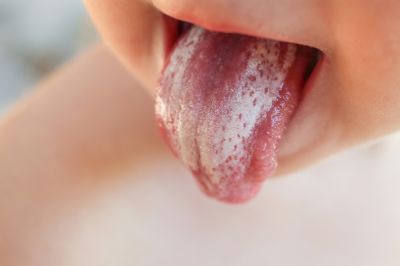- Your baby may be fretful, windy and more difficult to settle
- Your baby may be reluctant to feed as their mouth is sore
- You may notice white patches on your baby’s tongue and sides of their mouth
- Your baby may also have a nappy rash
My baby has thrush
Infant feeding and thrush
This can be a very painful condition and is caused by a fungal infection, Candida albicans, commonly known as thrush.

- DAKTARIN® (Miconazole) 2% oral gel - if your baby is under 4 months you will need to see your GP for a prescription.
- Apply 4 times a day after meals
- For correct application follow the patient information leaflet.
- Do Not put it to the back of your baby’s mouth as this may cause choking.
- Do Not give DAKTARIN® Gel from a spoon or syringe.
- DAKTARIN® Gel is available for purchase over the counter at a pharmacy for a baby over the age of 4 months.
- It is important to continue the treatment for a whole week after your baby is symptom free.
- Follow treatment instructions carefully.
- Complete the full course of treatment.
- Discard and replace all teats and dummies weekly.
- Steam sterilise for 2 cycles or boil for 10 minutes all feeding equipment.
Breastfeeding and thrush
If you are breastfeeding, you may experience thrush. It is extremely painful and affects both breasts at the same time. It may occur following a course of antibiotics. However, it is important to ask your Midwife or Health Visitor to check that your baby is attached well at the breast, as the pain from a poor attachment can be mistaken for thrush.
- You may have had sore, cracked nipples initially that have healed and breastfeeding was going well, then you experience a sudden onset of painful feeding.
- Your nipples may be itchy/burning and be pink, shiny and moist.
- The pain can be severe and continue after the feed has finished.
- After position and attachment has been observed, and support offered, if the pain has not improved, If you have thrush, it is important that both you and your baby are treated even if you cannot see any sign in your baby.
If you are taking a medicine called warfarin, DO NOT use Miconazole cream. Contact your GP for further advice. If baby has signs of thrush and you do not (and you are breastfeeding), you must get treatment for yourself.
- DAKTARIN® 2% (Miconazole) Cream
- Apply a small amount to your nipples after each feed and wipe, not wash off, any excess prior to the next feed.
- Apply after every breastfeed for 2 weeks.
- It is important to continue the treatment for a whole week after you and baby are symptom free
- DAKTARIN® Cream is available for purchase over the counter at a pharmacy.
- For both you and your baby the pain should ease in about 2-3 days after treatment has started.
- Some women experience a short recurrence of pain after about 7-10 days (for a day or so) which usually improves by itself.
- Follow treatment instructions carefully and complete the full course of treatment.
- Change breast pads after each feed. Wash clothes that come into contact with your breasts on a hot (50°C) wash cycle.
- Steam sterilise for 2 cycles or boil for 10 minutes all feeding equipment including pump parts.
- Discard and replace weekly any teats, dummies or nipple shields
- Hot temperatures kill thrush, cold does not.
- Do not freeze breast milk for later use during a thrush infection.
- You can still breastfeed whilst being treated.
IF THE PAIN STILL PERSISTS IN BOTH BREASTS AFTER YOU HAVE COMPLETED TREATMENT, YOU WILL NEED TO SEE YOUR GP FOR FURTHER ADVICE.
More information can be obtained via NHS Choices www.nhs.uk/conditions/oral-thrush-in-babies/
If you're still worried please contact your local Health Visitor.
References: http://cks.nice.org.uk, http://www.breastfeedingnetwork.org.uk



